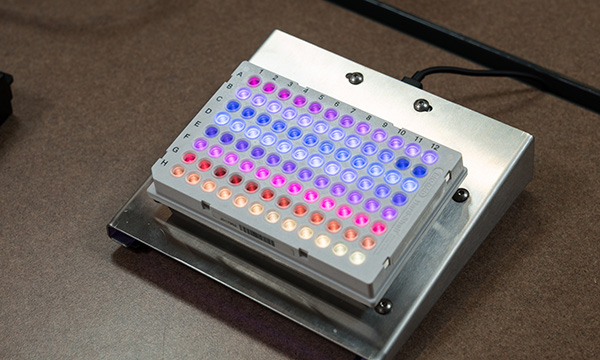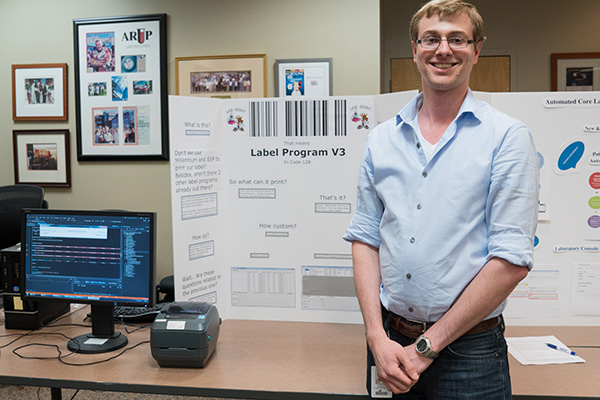
In normal use, Pipette-to-Light illuminates one well at a time so a technologist can correctly inoculate in a 96-well microtiter plate.
It’s a rapid, blinking play of colors. Ninety-six tiny indentations, or wells, in the microtiter plate used for tests including Lyme disease and other infectious conditions, are lit up like a disco or a child’s toy in the dark.
The play of lights is part of today’s showbiz presentation at ARUP’s Tech Fair, part of Lab Week, April 22-28. In normal use, this newly engineered solution for minimizing human error, Pipette-to-Light, illuminates one well at a time—so that a lab technologist can zero in on the numbered well to fill with specimen and/or testing antigen.
“It will make inoculating faster, and will help with accuracy for sure—that’s what I’m most excited for,” says Daniel Morris, Technologist I, Molecular Oncology, who worked on the end of this project and is at Tech Fair to help present.
Much building takes place at ARUP; in the last year, the company’s Automation Engineering completed more than 100 small projects for labs and finished four fully automated machines. A current project involves 800 in-house made parts and a mile of wire, cable, and tubing.
We’re excited about that and photos from ARUP’s Tech Fair, which showcases the inventions and innovations of individuals in Automation Engineering, Clinical Systems, Information Technology, and other in-house “builders” working to improve and speed the diagnostic processes of this national-reference laboratory. Much building takes place at ARUP; in the last year, the company’s Automation Engineering completed more than 100 small projects for labs and finished four fully automated machines. A current project involves 800 in-house made parts and a mile of wire, cable, and tubing. The innovations of Tech Fair are part of Lab Week, celebrated since 1975 in recognition of professional laboratory workers and their huge role in diagnosing medical conditions.
Stacy Saunders“This will add up to improvements in documentation, transparency, and quality of test changes—serving both internal and client needs.”
IT Clinical System Lead
Here are a few of the other booths present last week, showing technology that’s either new or upcoming at ARUP.

Test Information Management (TIM) Studio—Clinical Systems
Presented by Stacy Saunders, Chelsea Page (IT Clinical System Analyst), Jennifer Miller (IT Clinical System Analyst)
While ARUP has published Hotline notifications of test changes to clients through a Hotline document for years, the test changes were not available electronically and were not easily searchable. Also, the former process did not reliably capture changes that were not part of a Hotline.
The new in-house software solution TIM Studio captures client-notified Hotline changes back to 2004 and going forward; since January 2018, it has stored all test-changes details so the data can be easily shared with internal and external users. It also allows capture and reporting metrics such as types of changes, tests on multiple Hotlines, and the number of test changes by division.
“This will add up to improvements in documentation, transparency, and quality of test changes—serving both internal and client needs,” says Stacy Saunders, IT Clinical System Lead.
MPages—IT Project Management
Presented by Dina Cook (IT Business Systems Analyst II) and George Roberts (IT Software Programmer II)
MPages are various pages and dashboards within the Millennium lab-data system. Recently, the area known as Pending Processes was optimized to improve the user experience. Improvements include: robust searching, dynamic sorting, ability to print and copy, and choice of finding out whether an order previously was on Except.
A new Micro Dashboard was also added for the Microbiology Lab, which has many time-sensitive tests. Previously, the lab used an Excel spreadsheet to track how long certain tests pended. The new dashboard replaced the spreadsheet and has features that include separate monitors for Stat, Blood, Plating, and AFB Stain; color coding for hour/minute thresholds for pending tests; visibility of many factors including status, location, collected date, and order comments; and auto-refresh every five minutes.
“I’ve been working to ease former limitations of MPages and make them function more like regular, modern webpages. We’re making them faster, do more, and be more user-friendly. It’s exciting to see MPages make their way out of the year 1997,” George Roberts, IT Software Programmer II.
Label Program—Infectious Disease
Presented by Addison Redding, IT Software Programmer II
In the Infectious Disease Laboratory, a new label program designed by Addison Redding already provides customized label printing—and is now available to other labs. New printers can be added on the fly, and each printer can have its own label format. Users can print labels for certain (RITA) reagents, and create and save customized labels for other needs.
“I’m excited about the flexibility and versatility of the program. Since every lab can have their own unique format, the program can be expanded (out of Infectious Disease) to most anyone who wants it. In less than an hour, we were able to design, build, tweak, test and finish a new format for Cytogenics to use to fit their labels and needs,” says Redding.
Catherine Arnold, Science Communications Writer
Related blog
"The Spring Olympics? ARUP Seizes a Gold and Bronze in National Pipetting Challenge"
















